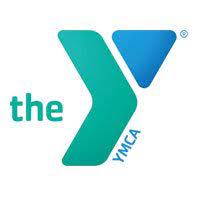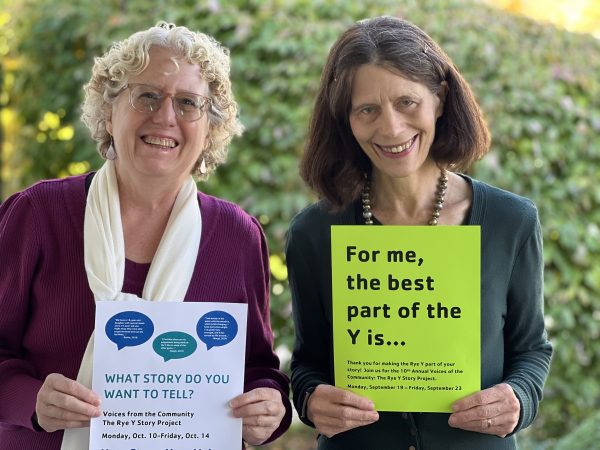In 2012 the YMCA of Rye, New York launched a story-collecting project to capture the personal experiences of its members, staff, and volunteers. Modeled loosely on StoryCorps, a national oral history nonprofit, “The Rye Story Project” has collected over 450 stories since then and has regularly shared them in on-site exhibits, marketing materials, annual reports, and social media.

When we first interviewed Lisa Tidball, Communications Director, and Denise Woodin, Director of Community Impact and Social Responsibility, in November 2013, they told us that capturing and sharing these stories helped build community, added a more personal touch to marketing materials, and supported the Rye Y’s fundraising efforts. With the project marking its 10th anniversary this month, we thought it would be a good time to reconnect with Lisa and Denise and find out what lessons they have learned with a decade of story collecting behind them.
Kirsten Farrell: I have a hunch there are plenty of lessons learned after ten years of collecting stories, but does one rise above all the others?
Denise Woodin: I think it’s that everyone has a story. While it may not be an earth-shattering “The Y Saved My Life” story – although we do get those – a lot of the stories are just “I bring my kids here for swim lessons and they love it,” or “This is just such a great place for our family to come and spend family time,” or a senior citizen telling us, “This is how I get out of the house. This is how I make social connections.” Sometimes those are the best stories.
Kirsten: Has the process changed over the years? Have you found some things that were more helpful in gathering or telling stories?

Denise Woodin and Lisa Tidball
Denise: For the most part, we hit on a formula right away that worked. One change is that a lot of interviewers, including myself, started out by recording people’s stories on a legal pad, writing them down. Now most of us are recording them on our phones, and it makes it a lot easier to transcribe them.
Lisa Tidball: I much prefer that because I can really focus on the person I’m talking to. Also, we always tell the story in first person. We started that out in the beginning, and that’s one of the things we ask our interviewers to do.
Denise: If you’re transcribing the person in their own words, it’s in their voice. It makes it fresher, more immediate. Most of the people that we use as interviewers are not writers. So, it’s easier for them to transcribe the story. Then they send it to me, and I go through and I edit. I edit very lightly. I take out the “ums”, I take out the repetitive things, but I try and keep it in the interviewee’s voice.
Lisa: We also send every story to the person we interviewed for their approval, so that they can feel comfortable with it.
Kirsten: Given that many of the interviewers are not professional journalists or necessarily storytellers, do you provide other guidelines to help them gather these stories?
Denise: We give them a tip sheet, and we try to do a 20-minute training every year. We give them a list of questions but we say, “Glance at this before the interview, but never look at it while you’re interviewing the person.” We want you to have a conversation with this person. Pretend it’s someone you’ve met at a cocktail party and you’re genuinely curious about them. How long have they been a member? Does their family come here? What are some of their goals? What are some of their challenges?
Lisa: And let the interviewee lead it. Let it take the form that they want.
Kirsten: You told us in 2013 that you regularly use the stories and in several different ways. How are you using them now, ten years in?
Lisa: Denise will read a story often before a board meeting, and it keeps the board members connected. We’ll put some stories in social media. We’ll put them in our annual report. We’ll use them throughout the year to remind people of who we are, the people who are benefiting from the Rye Y, and then we have our on site exhibit for people who are just coming to the Y, they’re bringing their child to swim, or they’re getting on the treadmill, and they may not be aware of all the important work we do.

On-site display of stories
Kirsten: I can imagine that it makes people feel so good if they work there, but also anyone who is in that space. Even if you’re just going to do some laps. Reading these stories must make people think, “I like being here in this space that provides so much to so many people.”
Lisa: Yes, and if you’re just having a hard time dragging yourself to a class, and then you read this amazing story about a person who came to the Y through all these different challenges, it’s helpful.
Denise: It’s great for staff morale too, because over and over again we hear people say what they love about coming here is the friendliness of the staff, the helpfulness of the staff, and they name them. So, if we put that in the story – “Caitlin and Rich greet us at the front desk and they know our names” that’s a great boost for our staff.
You can read examples from The Rye Y Story Project here and also access the interview tips they use, their permission form, and the PowerPoint they have used in the past to help spread this storytelling project to other organizations.
